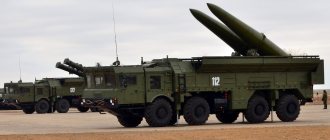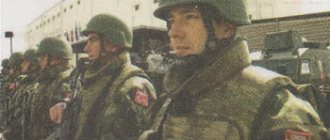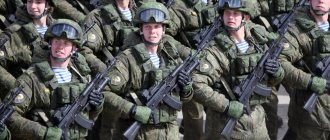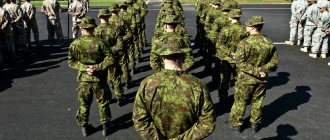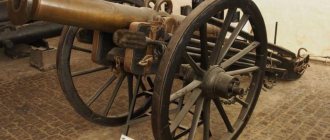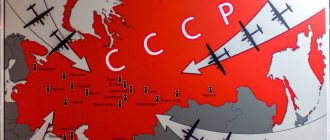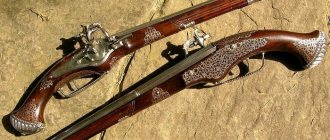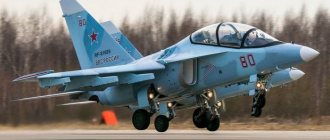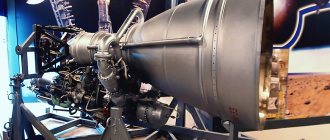Generations Park
The US Air Force has the world's largest number of aircraft of all classes and many types. In addition to aircraft and helicopters of regular units, reserve and national guard, a significant number of US Air Force vehicles are stored at the Davis-Monthan base (AMARG - Aerospace Maintenance and Regeneration Group, a group for the repair and restoration of aviation and space equipment), from where many of them may be returned to service. In the future, for the sake of brevity, these planes and helicopters will be referred to as being on AMARG.
The only type of ICBM in the US Air Force is the LGM-30 (“Minuteman-3”) silo-based, carrying from one to three nuclear warheads each. They are in service with the 20th VA Global Strike Command in the amount of 447 units. In addition, there are up to 243 missiles of the same type in storage, which are consumed as they are tested.
Heavy silo-based ICBMs LGM-118 (MX), capable of carrying 10 warheads each, have been withdrawn from service. At the same time, there are 56 undeployed missiles of this type, which are gradually being converted into space launch vehicles "Minotaur-IV" for launching military satellites.
The basis of American strategic aviation is the B-52H aircraft, each of which carries up to 20 ALCMs.
There are 76 bombers of this type in service, 12 more at AMARG, as well as 95 aircraft of the previous modification B-52G. Although the last B-52s were produced in 1960, they will remain in service with the US Air Force until the 2040s. For use with the B-52H, there are more than 1,400 AGM-86B/C/D ALCMs and more than 400 AGM-129A ALCMs.
The second strategic bomber of the US Air Force is the B-2A, built using Stealth technology.
Capable of carrying nuclear bombs, as well as a variety of conventional weapons. The Air Force has 20 aircraft of this type, of which one is used as an experimental one.
B-1B strategic bombers
converted for non-nuclear purposes. There are 62 B-1Bs in service, and 18 more on AMARG.
F-117 stealth aircraft
has a fighter designation, but is unable to conduct air combat due to aerodynamics and the lack of an on-board radar. Essentially it is a tactical bomber.
52 F-117A
withdrawn from the Air Force, but remain in storage at the Tonopah Air Force Base (Nevada) in fully combat-ready condition and can be quickly returned to service.
293 A-10 attack aircraft remain in service, with another 103 in AMARG.
The whereabouts of 57 aircraft of this type are unknown. Perhaps they will be converted into combat UAVs. In the future, it is they who are supposed to replace manned attack aircraft.
The MTR command has 30 armed transport aircraft (“Ganships”) AC-130 (16 U, 12 W, 2 J; on AMARG – another 1 U, 6 H), used in counter-guerrilla and special operations.
The C-141 Starlifter is a military transport aircraft.
Heavy fighter F-22A "Raptor"
At the moment, it is the only 5th generation fighter in the world in service with regular units. There are a total of 187 vehicles of this type in the US Air Force.
The F-22 was intended to replace the F-15 Eagle. Currently, up to 242 F-15 fighters (215 C, 26–27 D) remain in service, another 166 (54 A, 6 B, 97 C, 9 D) are in AMARG and 7 (3 A, 9 D) are in Air Force storage. 2 V, 2 C). The location of 14 F-15s (11 A, 3 B) is unknown.
In addition, there is a strike version of the F-15E Strike Eagle with limited air combat capabilities. There are 219 of these vehicles in service.
The 5th generation fighter, designed to replace the F-16 and A-10 attack aircraft, is the F-35A.
For our own needs, it is planned to produce 1,763 samples, but while the program is far behind schedule, only 92 F-35A have entered service. However, it is the only combat aircraft currently produced for the US Air Force.
The F-16 remains the most popular American fighter.
Now there are 958 of them in service (2 A, 1 B, 797 C, 158 D), on AMARG there are another 517 (248 A, 51 B, 204 C, 14 D). In addition, 20 F-16s (3A, 17C) have been converted to QF-16 targets. It is possible that they can also be used as combat UAVs. In total, it is planned to convert 126 F-16A and C early series into targets. The location of 24 F-16s (23 A, 1 C) is unknown. Apparently, some are being converted into targets, combat UAVs, and some have been disposed of.
AMARG still has 169 F-4 fighter-bombers and RF-4 Phantom reconnaissance aircraft of various modifications.
As was said, combat UAVs should in the future replace at least manned attack aircraft. The US Air Force currently has up to 150 MQ-1 Predator and 154 MQ-9 Reaper combat UAVs in service, with production of the latter continuing. However, these machines are capable of operating effectively only in the complete absence of enemy air defense, so they cannot yet become full-fledged substitutes for combat aircraft.
B-2 Spirit - a very expensive stealth bomber designed for tactical nuclear strikes against distant enemy forces
The US Air Force operates 4 VKP E-4Bs based on the Boeing 747. The AMARG hosts 14-15 EC-135s (the VKP based on the Boeing 707, which is designated the C-135 in the Air Force). There are 47 E-3 AWACS aircraft (16 A, 20 B, 4 C, 7 G; based on the Boeing 707), and AMARG has another 1 E-3G and 1 E-3A. All E-3As are formally transferred to the disposal of NATO and are conditionally assigned to Luxembourg. Legally, these 16 aircraft are the only NATO-wide aircraft; the rest of the aircraft belongs to specific countries that are members of the alliance.
The Air Force has 22 electronic warfare aircraft (RC-135 and RC-26B), 4 communications and relay aircraft (E-11A), 22 electronic warfare aircraft (EC-130), some of which can also be used for conducting psychological operations.
Reconnaissance and surveillance aircraft include 36–37 Beach-350 (MC-12W), 16 E-8C (another 1 on AMARG), 2 E-9A, 28 high-altitude U-2S and 4 TU-2S trainers, as well as 2 boards of the Open Skies program OS-135B (1 more on AMARG). 10 LC-130N are intended for ice reconnaissance, 2 WC-135 and 18 WC-130 are intended for meteorological reconnaissance.
The main tanker of the US Air Force is
created on the basis of the Boeing 707 KS-135: 399 vehicles in service (54 T, 345 R), 10 NKC-135 and 174–176 KC-135 (51–52 A, 4 D, 105 E, 14–15 R) – on AMARG. There are 59 more modern KS-10A (based on the DC-10).
The basis of US military transport aviation
consist of super-heavy S-5, heavy S-17 and medium S-130. Currently in service are 57 S-5 (5 A, 15 B, 1 S, 36 M), 222 S-17A and 338 S-130 (231 N, 107 J). On AMARG - 53 S-5A and 157 S-130 (21 H, 136 E).
Also in service are 21 light transport aircraft C-21A (Learjet-35A, 23 more on AMARG) and 16 C-12C, with 2 more on AMARG.
For transportation of senior officials of the state and the leadership of the Armed Forces
2 VC-25A (Air Force One, presidential aircraft-VKP based on the Boeing 747), 11 C-40 (Boeing 737), 11 C-32 (Boeing 757), and 12 S-37 and 6 S-20 (two modifications of the Gulf Stream passenger aircraft).
The MTR command has foreign-made light transport aircraft:
36 U-28 (Swiss RS-12), 18 C-146 (German Do-328) and 7 C-145A (Polish M-28, 9 more on AMARG). 60 MC-130 aircraft (AMARG has another 29 plus three in Air Force storage) are designed to land, resupply and evacuate special forces groups operating behind enemy lines. For rescue purposes, 33 NS-130 aircraft are used (AMARG uses another 16), 102 NN-60 helicopters and 43 CV-22B tiltrotors.
Training aviation
Includes 178 T-1A, 504 T-38 of various modifications (AMARG has another 149), 444 T-6A. The latter are being supplied to replace the T-38. In addition, 80 obsolete T-37Bs remain at AMARG.
The vast majority of US military helicopters are in service with the Army and Navy. The Air Force has about 76 UH-1s (up to 11 H, up to 65 N, AMARG has another 5–6), and the MTR command has up to 6 Russian Mi-8s in service.
With all this, the number of combat aircraft in the US Air Force is currently minimal for the period after World War II, and their average age is the largest in the entire history of American aviation.
Currently, only the F-35A is being produced, the production program of which is far behind the original schedule, but the price is many times higher than originally announced.
The US Air Force's immediate plans include the unification of various air systems and platforms into a single combat organism, in which all aircraft are communication compatible and exchange information about the combat situation in the air. Developments in this direction are being carried out in order to strengthen the interaction between aircraft of different generations.
But at the moment, most of the US aircraft in service were produced in the 1970s and 1980s. The old ones leave much faster than the new ones arrive. This gives rise to such an unexpected problem as a shortage of combat aircraft in the event of a large-scale war. The United States will be forced to carry out the F-35 program at any cost (literally and figuratively), since there is no alternative. Of course, combat UAVs will be created, and not only specialized ones. In any case, in the foreseeable future, the Chinese Air Force will be a serious competitor to American aviation. The United States does not have decisive air superiority over Russia.
US Air Force in NATO combat operations
Over the past decades, the United States and NATO have widely used aviation during local conflicts. The actions of aviation groups of the United States and their allies were characterized by the widespread use of high-precision weapons for various purposes.
In all campaigns, the attacking side focused its main aviation efforts on gaining strategic air superiority at the start of hostilities. This was achieved by violating state and military control, suppressing the air defense system, defeating aviation groups, and destroying the most important infrastructure facilities. In the campaigns under consideration, air defense troops (forces) were not included as an independent component in the created Air Force groupings.
The active use of the combat potential of US and NATO aviation in various military operations and conflicts, according to the military leadership of the bloc, will ensure they achieve their goals with virtually no combat losses in a relatively short time.
Operation Desert Storm in Iraq
In preparation for the war against Iraq, to protect the troops of the NATO coalition, as well as the most important military installations in the countries of the Persian Gulf zone from air strikes, the United States for the first time deployed a layered multicomponent air defense/missile defense system in the theater of operations. It consisted of a western and eastern group of land- and sea-based forces and assets. The first included Patriot anti-aircraft missile systems of the PAK-2.3 modifications of the US Ground Forces. The second are American cruisers and guided missile destroyers of the Ticonderoga and OrlyBurke type, equipped with the Indzhis automated combat control system (ACCS) and Standard-2 ship-based anti-aircraft guided missiles.
During Operation Desert Storm (Iraq, 1991), the following were deployed to control aviation: Air Force control posts; tactical control group of the French Air Force and the Saudi Arabian Air Force; tactical aviation control center (TAC); AWACS system AWACS aircraft. The technical basis of the control system is the automated control system of the strategic air command, US tactical aviation and satellite communication systems.
In Operation Desert Storm, the main form of use of aviation was an air offensive operation, and the main content was massive missile and air strikes (MRAU). The operational-tactical formation of MRAU forces and assets included:
1st echelon – sea-based cruise missiles (up to 100 missiles);
2 – suppression of the air defense system and disorganization of control (up to 175 aircraft),
3rd and 4th echelons - attack (from 120 to 300 aircraft).
Subsequently, systematic group and single air strikes and missile strikes were carried out against newly identified targets. The group's air defense forces and means provided cover for the most important administrative and industrial facilities, troop groups, air bases, and naval groups from attacks by Iraqi operational-tactical missiles and ensured raids by its strike aircraft.
During the first four days of Operation Desert Storm, cruise missiles accounted for only 16% of strikes. But after two months – 55%. During Operation Desert Fox (1998), the Kyrgyz Republic carried out about 72% of all strikes (more than 370 missiles). And if during Desert Storm 282 Tomahawk missiles were fired at the enemy in 43 days of the air campaign, then in Operation Iraqi Freedom there were already about 700 in 15 days.
US Air Force: what's next?
Currently, the development of the US air force is carried out in accordance with the plan “American Air Force: Challenge to the Future”, it was adopted in 2013.
This document notes the rapid development of scientific and technological progress, the instability of the geopolitical situation in the world, the increase in the number of local conflicts and the role of aviation in them.
The immediate plans of the US Air Force leadership are to achieve a full staffing of the Air Force with experienced pilots, for which they plan to increase their pay. Much attention is paid to training new UAV operators and eliminating the shortage of this specialty in the troops.
To improve the skills of UAV pilots and operators, it is planned to pay more attention to their training using special simulators and computer simulation tools. Much attention is paid to developing countermeasures against air defense systems.
In the coming years (until 2024), the US Air Force plans to purchase more than 1,700 new fifth-generation F-35 Lightning II aircraft. There is information that the Americans are planning to begin developing a sixth generation fighter and some companies have already shown interest in this project.
If we talk about other promising aircraft, the US Department of the Air Force hopes for the speedy completion of the program to create a new strategic bomber LRS-B. It will have to replace the overly expensive B-2. Although, it should be noted that the concept of using LRS-B has not yet been developed.
In their plans for the future, American strategists pay a lot of attention to the development of unmanned aircraft. The plans are to increase the number of such aircraft and completely replace the MQ-1 Predator with the MQ-9 Reaper.
The development of a new generation cruise missile, which will be armed with the B-52 bomber, is likely to continue.
Another promising direction is the development of hypersonic weapons that can hit the enemy due to high kinetic energy.
